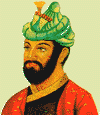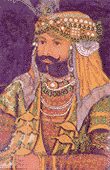
BABAR
 BABAR |
The Mughal period can be called a second classical age in northern India. In this cultural development, the Indian traditions were amalgamated with the Turko-Iranian culture, brought to the country by the Mughals. The Mughal rulers of India kept up the closest of contacts with Iran and there was a stream of scholars and artists coming over the frontiers to seek fame and fortune at the brilliant court of the Great Mughal, Babar. |
| He inherited a vast unconsolidated empire and an empty treasury. He also had to deal with the growing power of the Afghan Sher Shah, from the east, who had Bihar and Bengal under him. Sher Shah defeated Humayun in Kannauj (1540 AD) and Humayun passed the next twelve years in exile. In 1555, after Sher Shah's death, Humayun regained the throne from his weak successor. Akbar, his son, succeed him in 1556 AD, and consolidated the empire. He was such a good builder that the edifice he had erected lasted for another hundred years inspite of inadequate successors. |
 SHER SHAH |
 GOLD COIN |
There were many contacts with India during this period and the Arabs learnt much of Indian mathematics, astronomy and medicine. And yet, it would appear, that the initiative for all these contacts came chiefly from the Arabs and though the Arabs learnt much from India, the Indians did not learn much from the Arabs. Delhi flourished as an imperial capital for the Mughals and spread southwards. |
